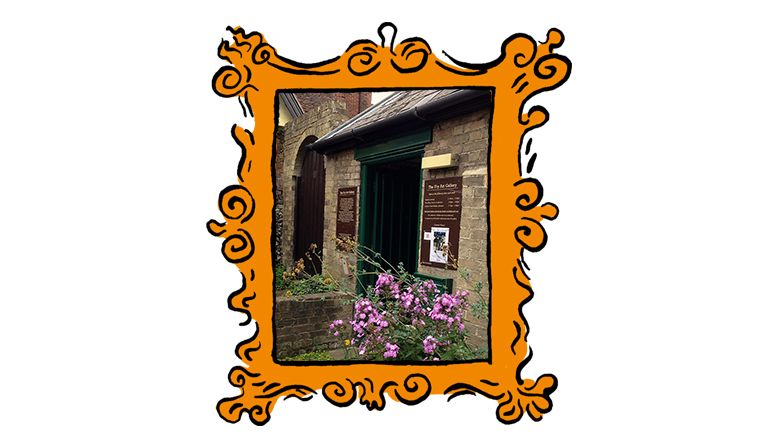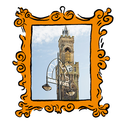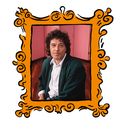The sign for the Fry Public Art Gallery in the picturesque Essex village of Saffron Walden points down a narrow alley between a row of colourfully painted, squat Tudor-style cottages. Pass under the brick archway that’s marked “Bridge End Garden”, walk down the passage, and the gallery is a low building on the left, bordered by neat hedges and beds of flowers, from which climbing plants scale its brick walls. Its glossy green doorway is impressively Victorian, as is the unexpected marble entrance hall inside. Its surreptitious location and inconspicuous exterior lend an air of secrecy to any visit; a feeling that the discovery that lies therein is yours and yours alone. Although a mere four rooms—the gilded hallway, two main galleries, and the Bawden Room (a little offshoot in one corner of the larger of the main spaces)—when it comes to its collection, the Fry punches well above its weight. It’s home to over 3,000 paintings, prints, illustrations, wallpapers, books and ceramics featuring design work by creatives who lived and worked locally, the most famous of whom are best known today as the Great Bardfield Artists.
This was a cluster of painters, designers, printmakers and ceramicists who, between the 1930s and the 1970s, gravitated to the small north-west Essex village of Great Bardfield and its environs, Saffron Walden included. Although not an assemblage or “school” in any formal sense, these artists were united in their pursuit of figurative art and design work—many of whom became particularly known for the latter—and in their envisioning of a rural (or rural-ish) artistic community as a counterpoint to the more traditional London scene.
The first to arrive, in 1931, were Eric Ravilious, his wife Tirzah Garwood and Edward Bawden. The men had been friends since first meeting as students at the Royal College of Art in South Kensington a decade earlier, which was also where Bawden met his future wife, Charlotte, a potter, who joined the trio in Great Bardfield after her and Bawden’s marriage in 1932. The year also brought John Aldridge to the area. Michael Rothenstein and Kenneth Rowntree arrived later, in 1941, by which point, both Ravilious and Bawden were working as official war artists. Bawden survived the conflict and returned to Great Bardfield in 1945, but Ravilious was killed, aged only 39, when the plane he was in was lost off Iceland. Garwood died nine years after him, from cancer, in 1951. Despite these significant losses, the Great Bardfield community swelled in the 1950s, as Marianne Straub, Sheila Robinson, George Chapman and Walter Hoyle all settled in the area.
The gallery itself dates back to 1856, when it was built by Francis Gibson, a local Quaker banker and businessman, to house the private art collection. It wasn’t until 1987 that the Fry Art Gallery Society requisitioned it with the specific aim of showcasing the art and telling the story of the Great Bardfield Artists. They use their impressive collection to curate a calendar of regularly changing exhibitions. Currently on show is Great Bardfield and Beyond: A Working Landscape, which examines how the Great Bardfield Artists didn’t over-sentimentalise the rural environment, instead paying particular attention to the labour that constituted the daily, working lives of the farming and local communities around them; and Working Women: The Art of Sheila Robinson and Chloë Cheese, mother and daughter, artists both.
Like Ravilious and Bawden—whose work encompassed everything from illustrated London Underground posters, designs for Wedgwood china, lithography, wood-engraving, watercolours and murals—Robinson turned her hand to a variety of mediums and commissions. Her commercial work included Schweppes advertisements, book jackets and internal illustrations, BBC Schools booklets, Festival of Britain publications, wallpaper designs and, of course, posters for the London Underground.
She moved to Great Bardfield with her husband Bernard Cheese and their one-year-old daughter Chloë, in 1953; and it was where mother and children (she had a second child, Ben) remained when the marriage disintegrated. In an essay included in the book that accompanies the exhibition, Sheila Robinson: Balance, Humanity and Nature, Chloë Cheese recalls just how “unusual” a position her mother was in, “as a lone woman and parent, to be working and well regarded.” Something that Robinson herself “played down… believing the quality of her work should speak for itself.” And it does. Without any question, whether her subject is her immediate domestic environment—her children playing with puppets in their small cottage in Punch, Top Hate and Toes (1965), or the unmatched crockery of Tea (1980)—or a scene more far-flung and exotic: a turtle in the aquarium at London Zoo or street scenes from Istanbul.
Cheese, too, finds many of her subjects in her immediate vicinity: a kettle, a single tulip in a vase, three golden pears lying in a bright blue colander, a biscuit box. Unsurprising, perhaps, given she grew up watching her mother work at the kitchen table in their cottage. But her colour palette is different; more pinks and turquoises than her mother’s tendency towards primary colours. And Cheese’s lines are less regimented, her shapes less clear-cut. Her works make me think of the 1980s in the same way that her mother’s work conjures up a feel of the 1950s and 1960s.
As Martin Salisbury, Professor of Illustration at the Cambridge School of Art, explains in his introductory essay to the book, the current trend for reappraising the work of many women artists who were in their own lifetimes underappreciated or ignored, combined with that for the breaking down of previously entrenched boundaries between fine art and illustration and design, not only allows us to marvel at Robinson’s work anew, but also that of the original Great Bardfield Artists. The Fry Gallery may be small, but the concentrated beauty and talent on show is magnificent. It’s well worth a visit.
Big fish in small fry
In the Essex village of Saffron Walden, the Fry Public Art Gallery punches above its weight
May 09, 2024

© Libby Norman / Wikimedia Commons









